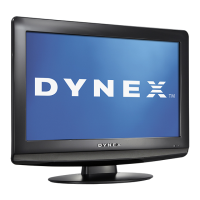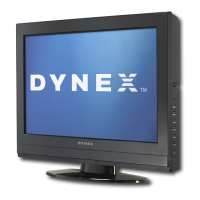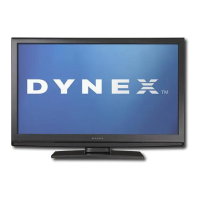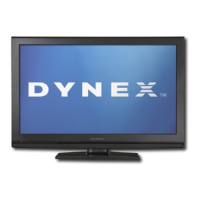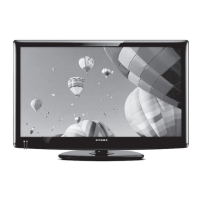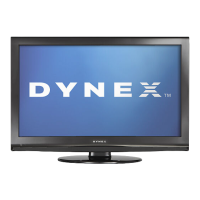Why is there no output from one of the speakers on my Dynex LCD TV?
- MMary OwensSep 9, 2025
Adjust the audio balance. Also, make sure that the audio cables are connected correctly and securely to the back of your TV.
Why is there no output from one of the speakers on my Dynex LCD TV?
Adjust the audio balance. Also, make sure that the audio cables are connected correctly and securely to the back of your TV.
What to do if my Dynex LCD TV has no power?
Make sure that the power cord is correctly connected to your TV and a power outlet. If it is, unplug the power cord, wait 60 seconds, then plug the cord back in and turn on your TV. Other devices may be interfering with your TV, so try turning off one device at a time to determine which device is causing interference. Once you have determined which device is causing interference, move it further from the TV to eliminate the interference.
What to do if my Dynex LCD TV has no picture and no sound?
First, press the power button on the TV or the remote control. Make sure the video cables are securely connected to the back of your TV and the power cord is plugged in. Adjust the contrast and brightness. Ensure that the correct video input source is selected. Try another channel to rule out station issues. Make sure the incoming signal is compatible. Also, confirm the antenna or cable TV is connected correctly and securely, and check the closed caption settings to ensure TEXT modes aren't blocking the screen.
Why Dynex LCD TV has good picture, but no sound?
First, increase the volume and make sure that the sound is not muted. Then, ensure the correct audio mode is selected. Check that the audio cables are connected correctly and securely to the back of your TV, and confirm the antenna or cable TV is connected correctly and securely. If you are using an antenna, the digital channel signal may be low. Also, the audio cables you are using may be faulty, so try a new set.
Why is my Dynex LCD TV showing a 'No signal' error message?
Press the INPUT button and make sure that you have selected the correct input for the device or service you are trying to use. If you are using a cable or satellite box, use the remote that came with that box to change channels.
What to do if my Dynex LCD TV has dark or poor picture, but sound is good?
Try another channel to rule out station problems. Ensure the antenna or cable TV is connected correctly and securely. Make sure that the Audio Only option is set to Off. Adjust the brightness and make sure that the correct picture mode is selected. If you are using an antenna, the digital channel signal may be low, so check the digital channel signal strength. If the signal strength is low, adjust the antenna or use a highly directional outdoor antenna or set-top antenna with a built-in amplifier. Also, make sure that the video cables are connected securely to the back of your TV and try a new set of video cables.
Why control buttons do not work on my Dynex LCD TV?
Make sure that the Button Lock option is set to No. If that doesn't work, unplug the power cord, wait a few seconds, then plug the cord back in and turn on your TV.
Why does my Dynex LCD TV keeps turning off?
Make sure that the sleep timer is not turned on.
How to fix audio noise on Dynex LCD TV?
Other devices (for example, surround sound receiver, external speakers, fans, or hair dryers) may be interfering with your TV. Try turning off one device at a time to determine which device is causing interference. Once you have determined which device is causing interference, move it further from the TV to eliminate the interference.
How to fix double images on Dynex LCD TV?
To resolve double images, use a highly directional outdoor antenna, cable TV, or satellite TV.
General safety tips for TV placement and use to prevent injury.
Guidelines for safely mounting the TV to a wall.
Numbered list of safety instructions for operating the TV.
Details on electric shock, lightning, power lines, LCD panel, and parts.
Covers damage requiring service, outdoor antenna grounding, condensation, mobile phones, and end-of-life.
Explains the appearance of non-active pixels on the LCD panel.
Step-by-step guide to attaching the TV stand.
Instructions for attaching a wall-mount bracket to the TV.
Lists the items included in the TV package.
Identifies and describes components on the front of the TV.
Identifies and describes components on the side of the TV.
Identifies and describes components on the back of the TV.
Details the function of each button on the remote control.
Guide to selecting the optimal connection type for video quality.
Instructions for connecting the TV to a power source.
How to connect a cable or satellite box using HDMI or DVI.
Detailed steps for connecting devices using HDMI.
Steps for connecting devices via DVI with audio.
Instructions for connecting component video devices.
Instructions for connecting composite video devices.
Steps for connecting via coaxial cable.
How to connect an antenna or cable TV without a box.
Steps for connecting a DVD or Blu-ray player.
Instructions for connecting HDMI or DVI devices.
Detailed steps for connecting component video devices.
Detailed steps for connecting composite video devices.
Instructions for connecting a VCR.
Steps for connecting a camcorder or game console.
Instructions for connecting a computer via VGA or HDMI.
Steps for connecting a computer using a VGA cable.
Steps for connecting a computer using an HDMI cable.
Instructions for connecting a USB flash drive.
How to connect headphones to the TV.
Steps for connecting a basic home theater system via analog audio.
Guide for connecting a home theater system with various devices.
Instructions for inserting batteries into the remote control.
Guidance on pointing the remote control towards the TV sensor.
Guide through the initial setup wizard for language, date, time, and source.
How to power the TV on and off using the power button.
How to choose the active video input source.
General guidance on navigating the TV's on-screen menus.
Methods for selecting channels using number buttons or channel list.
How to manually adjust TV picture settings for quality.
How to increase, decrease, or mute the TV volume.
How to display current program information and guide.
How to adjust picture settings when connected to a computer.
How to customize sound modes, treble, bass, and balance.
How to turn off the picture and listen to audio only.
Guide to scanning for available channels.
How to hide channels from the channel list.
How to create a list of favorite channels for quick access.
How to tune to channels from the favorite list.
How to add or change labels for channels.
How to check signal strength for optimal picture quality.
How to set or change the parental control password.
How to set content ratings to block specific programs.
How to enable or disable closed captioning.
How to choose different closed captioning modes.
How to set the TV's internal clock and date.
How to change the on-screen menu language.
How to assign custom labels to input sources.
How to view TV model and firmware information.
How to access the TV's USB mode.
How to view photos stored on a USB flash drive.
How to view photos added to the favorite list.
How to start and control a photo slideshow.
How to adjust slideshow repeat, shuffle, speed, and transition.
Instructions for safely cleaning the TV screen and surfaces.
Guidance on when and how to seek professional service.
Solutions for common video and audio issues.
Solutions for picture problems when sound is present.
Troubleshooting steps for incorrect color or dark pictures.
Solutions for static or noise appearing on the screen.
Solutions for visual artifacts like stripes or dots on the screen.
Troubleshooting steps for double images on the screen.
Solutions for when one speaker is not producing sound.
Information about permanent after-images on the screen.
Steps to troubleshoot a non-functional remote control.
Solutions for problems programming universal remotes.
Steps to take when the TV does not power on.
What to do when the "No signal" message appears.
Details about the product's warranty period and terms.
Physical dimensions and weight of the TV with and without stand.
Details about the screen size, type, resolution, and viewing angles.
Supported display resolutions and VGA scan rates.
Information about the TV's analog and digital tuner types.
List of available input ports on the TV.
List of available output ports on the TV.
Details on simulated surround sound and speaker output.
Information on power consumption and input voltage.
Other specifications like OSD languages, V-Chip, and VESA mount.
Instructions for programming a universal remote to control the TV.
List of common codes for controlling various devices.
Regulatory information regarding FCC rules and interference.
Requirements for using shielded cables for connectivity.
Compliance statement for Canadian digital apparatus.
Notice regarding Dolby trademarks and licensing.
Information about HDMI trademarks and licensing.
Note on meeting Energy Star requirements.
Defines terms used in the warranty statement.
Specifies the length of the warranty period.
Details what defects and issues are covered by the warranty.
Instructions on how to get warranty service for the product.
Specifies the geographic regions where the warranty is valid.
Lists exclusions and limitations of the warranty coverage.
| Display diagonal | 19 \ |
|---|---|
| Display brightness | 250 cd/m² |
| Display resolution | 1366 x 768 pixels |
| Native aspect ratio | 16:9 |
| Supported video modes | 720p |
| Viewing angle, vertical | 160 ° |
| Contrast ratio (dynamic) | 5000:1 |
| Contrast ratio (typical) | 1000:1 |
| Viewing angle, horizontal | 170 ° |
| Supported graphics resolutions | 1366 x 768 |
| 3D | No |
| Backlight | Yes |
| Product color | Black |
| Panel mounting interface | 100 x 100 mm |
| Tuner type | Analog & digital |
| Analog signal format system | NTSC |
| Digital signal format system | ATSC |
| RMS rated power | 2.3 W |
| Number of speakers | 2 |
| HDMI version | 1.4 |
| USB 2.0 ports quantity | USB 2.0 ports have a data transmission speed of 480 Mbps, and are backwards compatible with USB 1.1 ports. You can connect all kinds of peripheral devices to them. |
| S-Video inputs quantity | 0 |
| On/Off timer | - |
| AC input voltage | 120 V |
| AC input frequency | 60 Hz |
| Power consumption (standby) | 1 W |
| Power consumption (typical) | 26 W |
| Sustainability certificates | ENERGY STAR |
| Depth (with stand) | 138 mm |
|---|---|
| Height (with stand) | 330 mm |
| Weight (with stand) | 2900 g |
| Depth (without stand) | 44 mm |
| Width (without stand) | 456 mm |
| Height (without stand) | 297 mm |
| Weight (without stand) | 2700 g |
